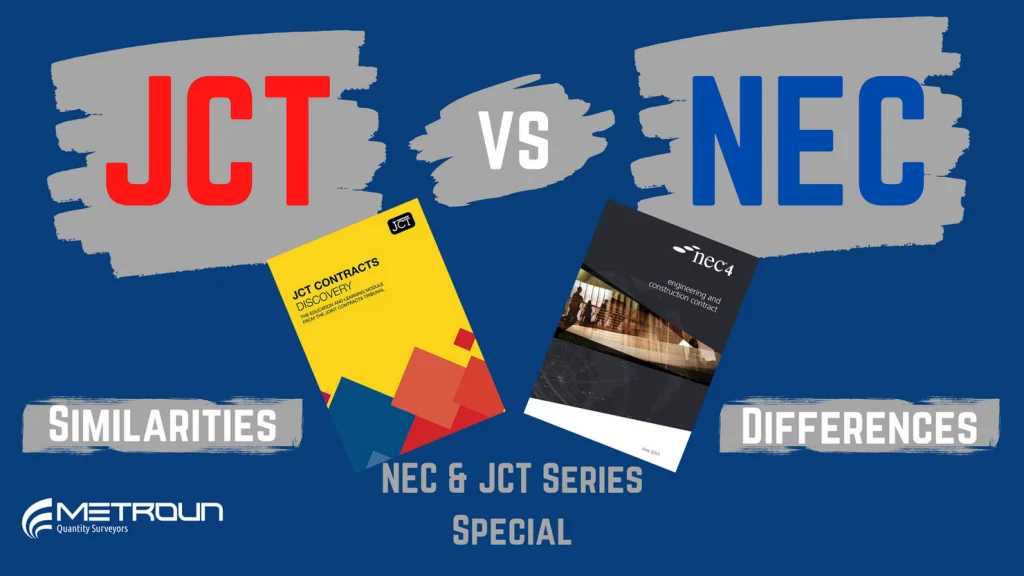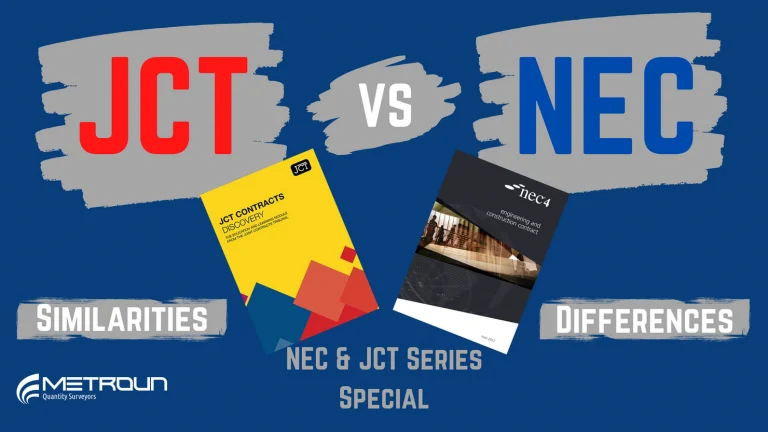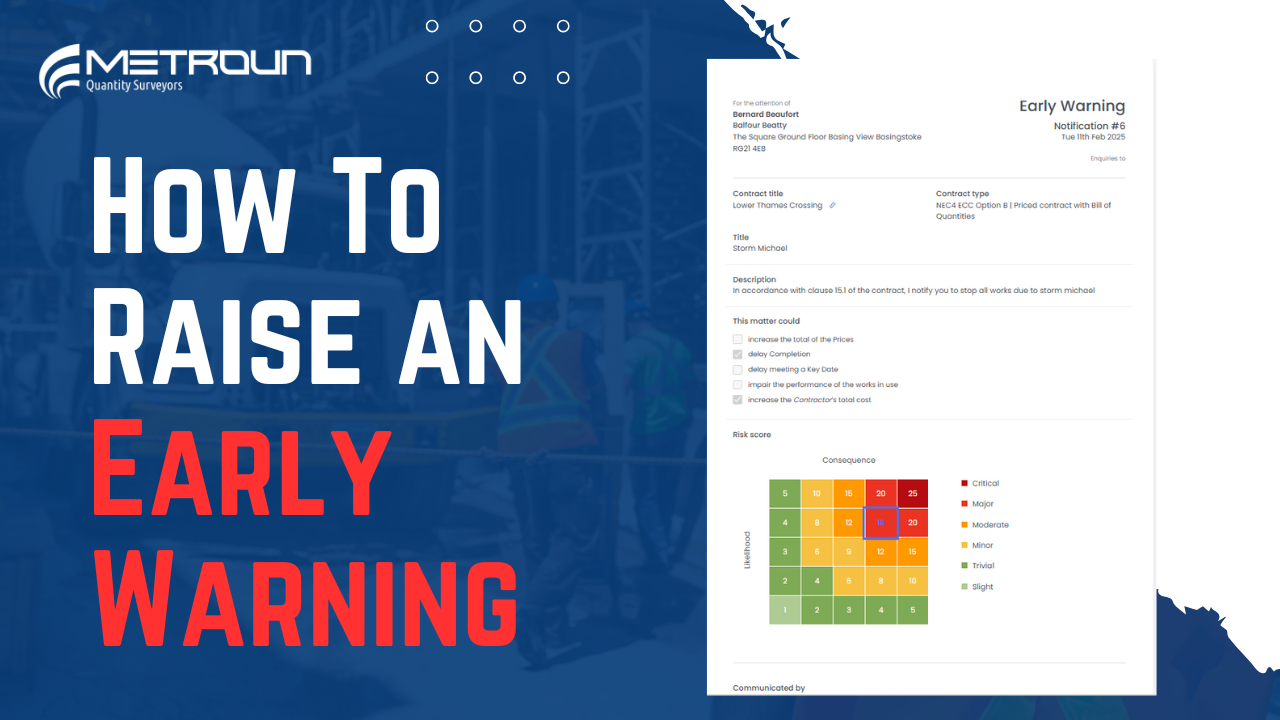Anyone working or studying a construction profession in the UK has likely heard of JCT and NEC. However, it is likely that you have worked, or will work on only one of these contracts within your career. For that reason we’ve created this article so you can have a basic understanding of what the differences are between the two.

The NEC which stands for New Engineering Contract is most certainly “Newer” then the JCT, with the first edition released in 1993. The JCT on the other hand, which stands for Joint Contracts Tribunal was established all the way back in 1931. As you can imagine, the NEC is often considered a more progressive contract, aiming to patch some of the downfalls of prior construction contracts. The JCT is often described as a more traditional contract [1]. Each contract appoints a person who acts on behalf of the employer. For the JCT contract they are known as the contract administrator and under the NEC they are known as the project manager.
Please click here for our selection of NEC tailored excel templates for download.
So let’s look into how these contracts are administered differently. We are going to split this down into two key areas: time and cost:
Time
Both contracts require the contractor to submit a programme for the works to be undertaken. Both contracts also require the employer to state a Starting Date, Completion Date, Access Dates and any Sectional Completions. However, the NEC requires a much more level of detail, containing key concepts such as float and time risk allowance [1]. The NEC uses the initial programme as a tool for how variations, earned value management and progress of the project is assessed. The JCT doesn’t stipulate what the programme should show and there are no requirements for revisions to be submitted. Under the NEC it is imperative that there is always an up-to-date accepted programme in place to ensure the contract runs smoothly. A key feature of addressing risk to programme extensions is Early Warnings. Under NEC these are submitted by either the Project Manager or Contractor as soon as one or the other becomes aware of any matter which could affect time, cost or quality of the works. These are usually followed by a risk mitigation meeting where parties will work collaboratively to mitigate risk. A task which would be extremely difficult without an up to date programme.
Cost
The cost to the employer goes in three stages initial price, variations and final/ interim payment. Both contracts address these stages differently. JCT is most commonly used as a lump sum contract with or without quantities. NEC goes further with pricing methods by providing the options to choose how work is procured [2]. These include cost based open-book contracts such as cost reimbursable or target cost options where the profit and loss is shared between employer and contractor [1]. Variations under JCT are known as “Relevant Events” and under NEC are known as “Compensation Events”. JCT deals with time and price variations separately, therefore an extension of time does not guarantee price adjustment. Unlike the NEC where both time and cost are grouped together under the Compensation Event. Both contracts have different conditions for what constitutes a variation. For example, unforeseen ground conditions which an experienced contractor could not have foreseen is a valid variation under NEC. However, this risk is carried by the contractor under JCT.
Summary
JCT is usually preferred by employers who want higher control over the project delivery. Providing a balance of risk between employer and contractor. Alternatively the NEC is the common choice for public sector work, this is due to the NEC’s focus on collaboration, which inspires innovation, risk reduction and mitigation of disputes by utilising an early on approach to issues on site. The NEC is therefore more often suited for major infrastructure and building.
Why not watch our youtube video on this subject?
The NEC which stands for New Engineering Contract is most certainly “Newer” then the JCT, with the first edition released in 1993. The JCT on the other hand, which stands for Joint Contracts Tribunal was established all the way back in 1931. As you can imagine, the NEC is often considered a more progressive contract, aiming to patch some of the downfalls of prior construction contracts. The JCT is often described as a more traditional contract [1]. Each contract appoints a person who acts on behalf of the employer. For the JCT contract they are known as the contract administrator and under the NEC they are known as the project manager.
Please click here for our selection of NEC tailored excel templates for download.
So let’s look into how these contracts are administered differently. We are going to split this down into two key areas: time and cost:
Time
Both contracts require the contractor to submit a programme for the works to be undertaken. Both contracts also require the employer to state a Starting Date, Completion Date, Access Dates and any Sectional Completions. However, the NEC requires a much more level of detail, containing key concepts such as float and time risk allowance [1]. The NEC uses the initial programme as a tool for how variations, earned value management and progress of the project is assessed. The JCT doesn’t stipulate what the programme should show and there are no requirements for revisions to be submitted. Under the NEC it is imperative that there is always an up-to-date accepted programme in place to ensure the contract runs smoothly. A key feature of addressing risk to programme extensions is Early Warnings. Under NEC these are submitted by either the Project Manager or Contractor as soon as one or the other becomes aware of any matter which could affect time, cost or quality of the works. These are usually followed by a risk mitigation meeting where parties will work collaboratively to mitigate risk. A task which would be extremely difficult without an up to date programme.
Cost
The cost to the employer goes in three stages initial price, variations and final/ interim payment. Both contracts address these stages differently. JCT is most commonly used as a lump sum contract with or without quantities. NEC goes further with pricing methods by providing the options to choose how work is procured [2]. These include cost based open-book contracts such as cost reimbursable or target cost options where the profit and loss is shared between employer and contractor [1]. Variations under JCT are known as “Relevant Events” and under NEC are known as “Compensation Events”. JCT deals with time and price variations separately, therefore an extension of time does not guarantee price adjustment. Unlike the NEC where both time and cost are grouped together under the Compensation Event. Both contracts have different conditions for what constitutes a variation. For example, unforeseen ground conditions which an experienced contractor could not have foreseen is a valid variation under NEC. However, this risk is carried by the contractor under JCT.
Summary
JCT is usually preferred by employers who want higher control over the project delivery. Providing a balance of risk between employer and contractor. Alternatively the NEC is the common choice for public sector work, this is due to the NEC’s focus on collaboration, which inspires innovation, risk reduction and mitigation of disputes by utilising an early on approach to issues on site. The NEC is therefore more often suited for major infrastructure and building.
Why not watch our youtube video on this subject?
The NEC which stands for New Engineering Contract is most certainly “Newer” then the JCT, with the first edition released in 1993. The JCT on the other hand, which stands for Joint Contracts Tribunal was established all the way back in 1931. As you can imagine, the NEC is often considered a more progressive contract, aiming to patch some of the downfalls of prior construction contracts. The JCT is often described as a more traditional contract [1]. Each contract appoints a person who acts on behalf of the employer. For the JCT contract they are known as the contract administrator and under the NEC they are known as the project manager.
Please click here for our selection of NEC tailored excel templates for download.
So let’s look into how these contracts are administered differently. We are going to split this down into two key areas: time and cost:
Time
Both contracts require the contractor to submit a programme for the works to be undertaken. Both contracts also require the employer to state a Starting Date, Completion Date, Access Dates and any Sectional Completions. However, the NEC requires a much more level of detail, containing key concepts such as float and time risk allowance [1]. The NEC uses the initial programme as a tool for how variations, earned value management and progress of the project is assessed. The JCT doesn’t stipulate what the programme should show and there are no requirements for revisions to be submitted. Under the NEC it is imperative that there is always an up-to-date accepted programme in place to ensure the contract runs smoothly. A key feature of addressing risk to programme extensions is Early Warnings. Under NEC these are submitted by either the Project Manager or Contractor as soon as one or the other becomes aware of any matter which could affect time, cost or quality of the works. These are usually followed by a risk mitigation meeting where parties will work collaboratively to mitigate risk. A task which would be extremely difficult without an up to date programme.
Cost
The cost to the employer goes in three stages initial price, variations and final/ interim payment. Both contracts address these stages differently. JCT is most commonly used as a lump sum contract with or without quantities. NEC goes further with pricing methods by providing the options to choose how work is procured [2]. These include cost based open-book contracts such as cost reimbursable or target cost options where the profit and loss is shared between employer and contractor [1]. Variations under JCT are known as “Relevant Events” and under NEC are known as “Compensation Events”. JCT deals with time and price variations separately, therefore an extension of time does not guarantee price adjustment. Unlike the NEC where both time and cost are grouped together under the Compensation Event. Both contracts have different conditions for what constitutes a variation. For example, unforeseen ground conditions which an experienced contractor could not have foreseen is a valid variation under NEC. However, this risk is carried by the contractor under JCT.
Summary
JCT is usually preferred by employers who want higher control over the project delivery. Providing a balance of risk between employer and contractor. Alternatively the NEC is the common choice for public sector work, this is due to the NEC’s focus on collaboration, which inspires innovation, risk reduction and mitigation of disputes by utilising an early on approach to issues on site. The NEC is therefore more often suited for major infrastructure and building.
Why not watch our youtube video on this subject?

References:









